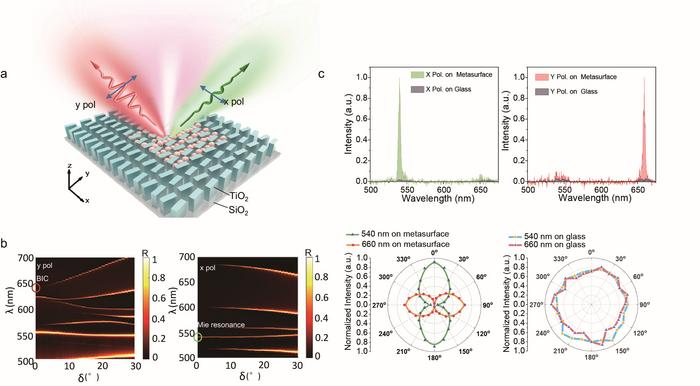Lanthanide-doped upconversion nanoparticles (UCNPs) exhibit several excellent features, including broadly tunable multicolor emission and extended emission lifetimes. As a result, they are well-suited for a wide range of light-emission applications. Despite several benefits, continued advancement and practical implementations of UCNPs confront major obstacles. Another significant aspect of fluorescence is polarization. It adds another layer to orientation and structural information.
 a) Schematic presentation of a resonant metasurface with high-Q quasi-BIC and Mie resonant modes. b) The evolution of reflection spectra by continuously varying the geometry asymmetry parameter δ under y- and x- linearly polarized illumination. c) Upconversion luminescence spectra from UCNPs deposited on the metasurface and glass substrate. Image Credit: Ziwei Feng, Tan Shi, Guangzhou Geng, Junjie Li, Zi-Lan Deng, Yuri Kivshar, and Xiangping Li
a) Schematic presentation of a resonant metasurface with high-Q quasi-BIC and Mie resonant modes. b) The evolution of reflection spectra by continuously varying the geometry asymmetry parameter δ under y- and x- linearly polarized illumination. c) Upconversion luminescence spectra from UCNPs deposited on the metasurface and glass substrate. Image Credit: Ziwei Feng, Tan Shi, Guangzhou Geng, Junjie Li, Zi-Lan Deng, Yuri Kivshar, and Xiangping Li
Polarization is often used in the fluorescence polarization imaging method. In UCNPs, the intrinsic upconversion emission processes associated with the 4f electronic transition are usually weak and lack polarization.
A team of scientists led by Professors Xiangping Li and Zi-Lan Deng (Jinan University), Junjie Li (Institute of Physics, CAS), and Yuri Kivshar (Australian National University) created a dielectric metasurface for the amplification of upconversion emissions in a new study published in eLight.
Most earlier studies concentrated on improving upconversion luminescence by combining UCNPs with plasmonic nanostructures. The intense electromagnetic field around these nanostructures can increase absorption cross-sections and upconversion radiation rates. Metallic structures enable surface plasmons to effectively localize light and generate strong electric fields, which improves upconversion fluorescence.
Due to inherent loss, metallic nanostructures have poor quality factor (Q factor) values. Because of direct contact with the emission materials, they can produce a quenching effect. For resonant excitation, the Q value is critical.
The average Q factor range for plasmonic resonances is a few tens. Metal-insulator-metal (MIM) structures, for example, can achieve a high Q factor. The emitters are in close proximity to the metallic surface. The quenching effect causes the quantum efficiency to rapidly decrease.
All-dielectric resonant metasurfaces built of high-index dielectric nanostructures with minimal losses at visible frequencies enable substantially richer multipolar Mie-resonances than plasmonic nanostructures. It is an excellent alternative to fluorescence enhancement. When these Mie multipoles are coupled in periodic arrays, collective high-Q resonances occur.
By breaking meta-atom symmetry, bound states in the continuum (BICs) can be transformed into a quasi-BIC with finite but very large Q factors. These new approaches have lately been thoroughly investigated and demonstrated for fluorescence enhancement and low-threshold lasing applications.
For polarization-controlled dual-band upconversion bursts, the researchers used the developing concept of high-Q collective modes of resonant metasurfaces. The researchers created high-Q resonant metasurfaces out of diatomic nano bricks.
The design includes a quasi-BIC mode for y-polarized incidence and a high-Q Mie resonance mode for x-polarized incidence. The ultrabright upconversion luminescence of NaYF4:Yb/Er UCNPs placed on the metasurface is seen in dual bands.
The researchers showed linearly and cross-polarized emission at dual bands with ultra-high degrees of polarization (DoPs) by adjusting the rotation of the polarization analyzer. The study paves the way for effective UCNP emission enhancements and polarization control, with applications in low-threshold polarization upconversion lasers and hyperspectral imaging/sensing.
Journal Reference:
Feng, Z., et al. (2023) Dual-band polarized upconversion photoluminescence enhanced by resonant dielectric metasurfaces. eLight. doi:10.1186/s43593-023-00054-2